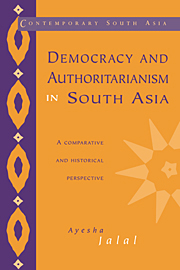Book contents
- Frontmatter
- Contents
- List of maps
- Preface
- Introduction
- 1 The colonial legacy in India and Pakistan
- 2 State formation and political processes in India and Pakistan, 1947 to c.1971
- 3 The ‘populist’ era and its aftermath in India, Pakistan and Bangladesh, 1971 to c.1993
- 4 The state and political economy, 1947 to c.1993
- 5 Central power and regional dissidence
- 6 Societies, cultures and ideologies: hybrids in contrived monoliths
- 7 Conclusion
- Bibliographical essay
- Index
1 - The colonial legacy in India and Pakistan
Published online by Cambridge University Press: 26 October 2009
- Frontmatter
- Contents
- List of maps
- Preface
- Introduction
- 1 The colonial legacy in India and Pakistan
- 2 State formation and political processes in India and Pakistan, 1947 to c.1971
- 3 The ‘populist’ era and its aftermath in India, Pakistan and Bangladesh, 1971 to c.1993
- 4 The state and political economy, 1947 to c.1993
- 5 Central power and regional dissidence
- 6 Societies, cultures and ideologies: hybrids in contrived monoliths
- 7 Conclusion
- Bibliographical essay
- Index
Summary
Few political decisions in the twentieth century have altered the course of history in more dramatic fashion than the partition of India in 1947. To be sure, the end of formal colonialism and the redrawing of national boundaries was a tumultuous event, sending tremors throughout much of Asia and beyond. Yet perhaps nowhere was the shock felt more intensely or more violently than in the Indian subcontinent. Economic and social linkages which over the millennia had survived periods of imperial consolidation, crises and collapse to weld the peoples of the subcontinent into a loosely layered framework of interdependence were rudely severed. Political differences among Indians over the modalities of power sharing once independence had been won sheared apart the closely woven threads of a colonial administrative structure that had institutionally integrated, if never quite unified, the subcontinent. That the culmination of some two hundred years of colonial institution-building should have sapped the subcontinent's capacity for accommodation and adaptation is a telling comment on the ways in which imperialism impressed itself on Indian society, economy and polity.
A rich and complex mosaic of cultural diversities which had evolved creative political mechanisms of compromise and collaboration long before the colonial advent, India through the centuries had managed to retain its geographical unity despite the pressures imposed by military invasion, social division and political conflict. There was little agreement on the basis of this unity or on its precise boundaries.
- Type
- Chapter
- Information
- Democracy and Authoritarianism in South AsiaA Comparative and Historical Perspective, pp. 9 - 28Publisher: Cambridge University PressPrint publication year: 1995
- 3
- Cited by

